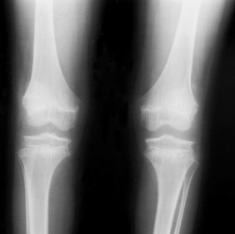Medicine:Hall-Riggs syndrome
From HandWiki
| Hall-Riggs syndrome | |
|---|---|
 | |
| Radiograph of a 9-year old child with the condition showing dysplastic changes of the epiphyses and metaphyses within his knees. | |
| Specialty | Medical genetics |
| Symptoms | skeletal dysplasia, facial deformities, intellectual disabilities |
| Usual onset | Birth |
| Duration | Lifelong |
| Causes | Autosomal recessive genetic disorder |
Hall-Riggs syndrome is a rare genetic disorder that causes neurological issues and birth defects.[1] People with Hall-Riggs syndrome usually have skeletal dysplasia, facial deformities, and intellectual disabilities.[2] Only 8 cases from 2 families worldwide have been described in medical literature.[2] It is an autosomal recessive genetic disorder, meaning both parents must carry the gene in order for their offspring to be affected.[1]
Common characteristics of Hall-Riggs syndrome include:[3][4]
- spondyloepimetaphyseal dysplasia
- short stature
- shortened limbs, fingers, and toes
- microcephaly
- scoliosis
- seizures
- widened nasal bridge and mouth
- other dysmorphic facial features
- intellectual disabilities
- recurrent vomiting episodes
Cases
- 1975: Hall and Riggs describe 6 out of 15 children born to consanguineous parents.[5] Said children had severe intellectual deficit, microcephaly, facial dysmorphisms consisting of nostril anteversion, depressed nasal bridge and large lips, and progressive dysplasia of the skeletal system, including scoliosis, flattened femoral heads, shortened femoral necks, shortened proximal segments of the arms, growth delays, and epiphyseal flattening affecting the fingers and ankles. Said children didn't acquire the ability of speech even in adulthood. The parents of the 15 children were healthy, unaffected first-cousins.[5]
- 2000: Silengo and Rigardwtto describe two Italian siblings of the opposite sex born to healthy, unaffected non-consanguineous parents.[6] Said children had the same symptoms as the previously described family alongside short stature and hypertelorbitism, Spondylometaphyseal dysplasia and mild epiphyseal changes were confirmed through radiographs. MRI findings included the presence of cavum vergae and multiple cysts in the septum pellucidum. EEGs came back abnormal. High-resolution karyotypes came back normal. The brother had a history of seizures and psychomotor instability and agitation. Other symptoms included brachydactyly type D, dorsal kyphosis, platyspondyly, enamel hypoplasia, coarse and thick hair, and feeding difficulties.[6]
References
- ↑ 1.0 1.1 "Hall-Riggs syndrome - About the Disease - Genetic and Rare Diseases Information Center" (in en). https://rarediseases.info.nih.gov/diseases/2586/hall-riggs-syndrome.
- ↑ 2.0 2.1 "Entry - 234250 - HALL-RIGGS MENTAL RETARDATION SYNDROME - OMIM" (in en-us). https://omim.org/entry/234250#2.
- ↑ RESERVED, INSERM US14-- ALL RIGHTS. "Orphanet: Hall Riggs syndrome" (in en). https://www.orpha.net/consor/cgi-bin/OC_Exp.php?lng=en&Expert=2107.
- ↑ Bissonnette, Bruno; Luginbuehl, Igor; Engelhardt, Thomas (2019), "Hall Riggs Syndrome", Syndromes: Rapid Recognition and Perioperative Implications (New York, NY: McGraw-Hill Education), http://accessanesthesiology.mhmedical.com/content.aspx?aid=1164071964, retrieved 2022-08-27
- ↑ 5.0 5.1 Hall, B. D.; Riggs, F. D. (1975). "A new familial metabolic disorder with progressive osseous changes, microcephaly, coarse facies, flat nasal bridge and severe mental retardation". Birth Defects Original Article Series 11 (5): 79–90. ISSN 0547-6844. PMID 1218240. https://pubmed.ncbi.nlm.nih.gov/1218240/.
- ↑ 6.0 6.1 Silengo, Margherita; Rigardetto, Roberto (2000-11-01). "Hall-Riggs syndrome: a possible second affected family?" (in en). Journal of Medical Genetics 37 (11): 886–889. doi:10.1136/jmg.37.11.886. ISSN 0022-2593. PMID 11185076. PMC 1734460. https://jmg.bmj.com/content/37/11/886.
 |

